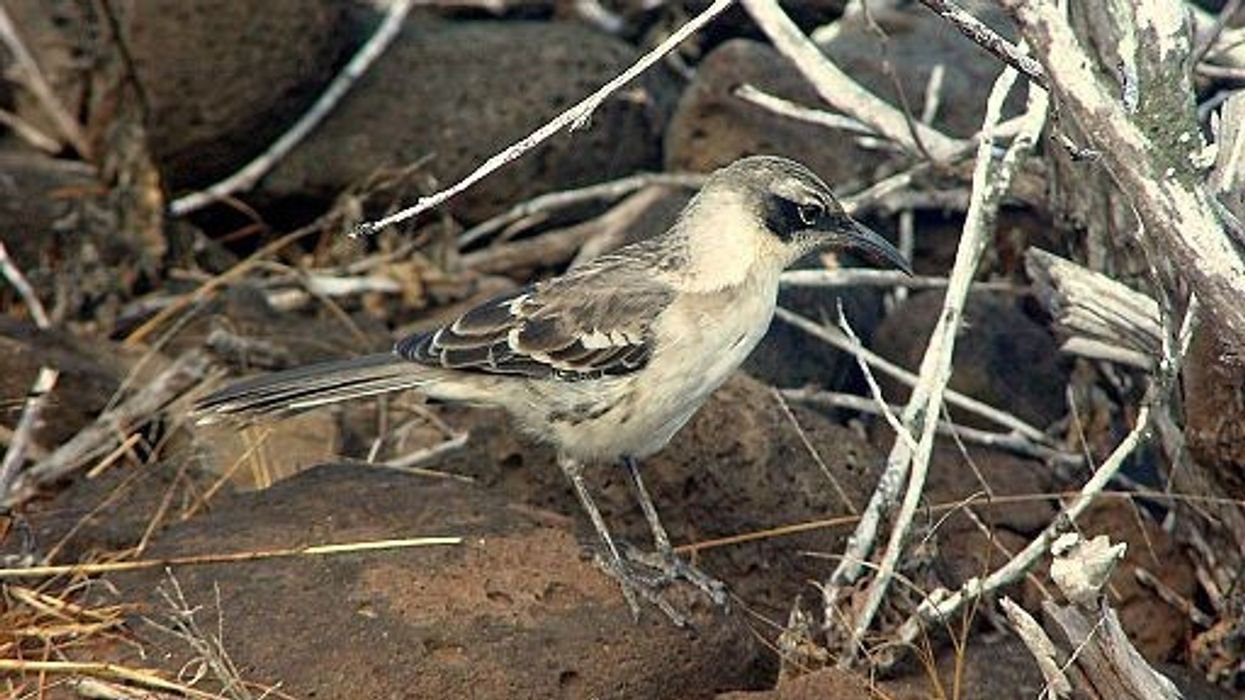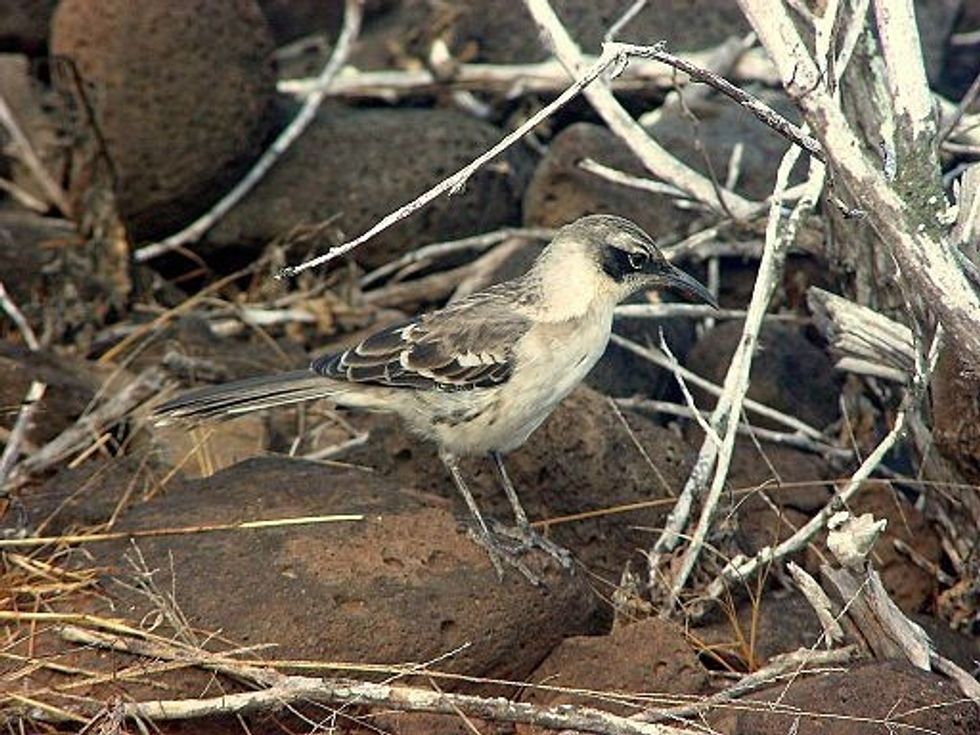Are you fascinated by small birds like the tufted titmouse? Then, you may love the Galapagos mockingbird.
The Galápagos mockingbird is found solely in the Galápagos Islands of Ecuador in South America. The mockingbirds living on the Genovesa Island situated in the northeastern part of the archipelago are believed to be most densely inhabited by this species.
The Galápagos mockingbirds are small in size, however, their bold and aggressive traits make them so unique and popular among the readers as well as the tourists traveling to the Galapagos Islands. They are mainly gray plumage with sharp beaks and loud calls.
Charles Darwin, the father of evolution, mentioned the Galápagos mockingbirds in his famous book 'The Voyage Of The Beagle'. Darwin collected specimens of all four species of mockingbirds which helped Darwin in researching the theory of evolution.
Galápagos Mockingbird Interesting Facts
What type of animal is a Galápagos mockingbird?
A Galapagos mockingbird is a small-sized territorial bird as the name of the species 'parvulus' suggests which means 'very small' in Latin. The birds are even smaller in size than robins yet they are very aggressive.
These bird species are endemic to the Galapagos Islands and live with its six other sub-species and three other species including those of the Floreana and Española Islands.
What class of animal does a Galápagos mockingbird belong to?
A Galapagos mockingbird belongs to the class of Aves under the kingdom of Animalia.
How many Galápagos mockingbirds are there in the world?
The population of this specific mockingbird species in the world is not estimated. The birds are endemic to the islands of the Galapagos in South America yet their number is not quantified due to their wide distribution and abundant population across the island unlike the endangered species of the Floreana mockingbird living on the same island.
Where does a Galápagos mockingbird live?
A Galapagos mockingbird lives and dwells across the scrublands, sandy beaches. They are even found living in the tropical forests and mangroves of the American continent.
What is a Galápagos mockingbird's habitat?
The Galapagos mockingbird habitat is endemic to the Galapagos Islands (the island famously known for Darwin's theory of evolution) which is situated in the eastern Pacific Ocean.
The island is 926 km away from the mainland of Ecuador, a country in South America.
The Galapagos mockingbirds along with the other mockingbird species of the four species (namely, the Floreana mockingbird or Darwin's mockingbird, the San Cristobal mockingbird, the Hood mockingbird of the Española Island), and six subspecies of their own are found to live in these islands.
The Galapagos mockingbirds are found inhabiting a wide variety of geographical land of the Galapagos Island as the scrublands with shrubs and cacti where they make their nests, they are also found living in the tropical forests and mangroves, as well as the sandy coastal regions of the Galapagos Island.
This specific species of Galapagos mockingbird are the most widely distributed in the Galapagos Islands except the islands of Champion near Floreana, Española with the hood mockingbirds, and San Cristobal with the San Cristobal mockingbirds.
Who do Galápagos mockingbirds live with?
The Galapagos mockingbirds are found to live in flocks. They often create social groups with social roles assigned to specific individuals along with specific gender roles and inequalities marked within the boundaries of specific territorial land.
A social group of mockingbirds is led by an adult male social group and contains a major number of male birds, young birds, few female birds mainly engaged in the process of breeding.
How long does a Galápagos mockingbird live?
The lifespan of a Galapagos mockingbird is unknown as they are only found in the regions of the Galapagos Island which are uninhabitable for humans. The birds were spotted by tourists and a few researchers traveling to those islands.
How do they reproduce?
The breeding usually occurs between two birds of similar ranks, inbreeding is also practiced by the mockingbird species of the Galapagos archipelago. The breeding season ranges from October to April depending on the first rain of the year. The female birds lay three or four eggs in a single brooding.
What is their conservation status?
The Galapagos mockingbirds found living in the archipelago are abundantly populated and are widely distributed across the Genovesa Islands unlike the endangered species of the Floreana mockingbird or Darwin's mockingbird hence according to the International Union for Conservation of Nature, the Galapagos mockingbirds are regarded as the least concerned bird species.
Galápagos Mockingbird Fun Facts
What do Galápagos mockingbirds look like?

The adults of the Galapagos mockingbirds are mostly gray with dark brownish shades found across their long tails and wings along with white patches at the end or tips of the flight feathers, the Galapagos mockingbirds have long and black legs, the wings are shorter and the beak is black and sharp, the plumage near the abdomen is lighter in a color that ranges from gray to light gray or white, the color of their eyes are yellowish and black with an appealing white ring around them.
How cute are they?
A Galapagos mockingbird may seem cute especially to the tourists as they are easily approachable and are not scared of humans, however, they exhibit naturally aggressive behavior towards other comparatively larger birds like hawks and animals like iguanas and are very annoying to the researchers traveling to the island.
The Galapagos mockingbird is known to defend its nests with loud calls and a fierce attitude, especially during the breeding season and when attacked by predators.
How do they communicate?
The Galapagos mockingbird uses loud calls or sounds while communicating with the other members of the social group, they are also found to produce songs during the breeding season.
The Galapagos mockingbird, as its name suggests, is popularly believed to mimic the calls or sounds of the other wildlife creatures on the island like that of the iguanas, however, there is not enough evidence of such a trait of this bird.
How big is a Galápagos mockingbird?
A Galapagos mockingbird weighs about 0.112-0.123 lb (50-54.4 g) with a length of 9.84-10.23 in (25-25.9 cm). They are lighter in weight than the Floreana mockingbird and longer than the hood mockingbird species found in the Española islands.
Their small size doesn't affect their natural aggressive behavior and is capable of attacking much larger birds like the hawks. When compared to the loggerhead shrike, they are slightly similar as loggerhead shrikes stand at a height of 8-10 in (20-25.4 cm).
How fast can a Galápagos mockingbird fly?
Galapagos mockingbirds are not great birds of flight and prefer running and walking rather than flying while roaming around the island for food and other necessities like creating nests and bringing food for the nestlings.
How much does a Galápagos mockingbird weigh?
A Galapagos mockingbird weighs about 0.112-0.123 lb (50-54.4 g)
What are their male and female names of the species?
The male and female birds of the Galapagos mockingbirds have no distinct names.
What would you call a baby Galápagos mockingbird?
The young ones of the mockingbirds are often generally referred to as nestlings or chicks without any specific name being given to them.
What do they eat?
The birds of this species eat a variety of food like seeds, and invertebrates like caterpillars, centipedes, grasshoppers, and crickets. They also eat small lizards, seabird eggs, bird chicks, and baby turtles among others.
These birds are found to feed on lice and worms found in the bodies of the iguanas. They are not only omnivores but are scavengers too; they are found feeding on dead wildlife creatures like the sea lions found on the island.
Are they dangerous?
These birds are small in size however their natural aggressiveness makes them dangerous to the seabird eggs and even other larger creatures who might accidentally end up intruding on their territory, especially during the breeding season.
Would they make a good pet?
These birds do not make good pets due to their wild and aggressive nature, they prefer to live in flocks in the wild, and petting them has become illegal to prevent the birds from becoming endangered.
Did you know...
One of the most bewildering Galapagos mockingbird facts is their practice of cooperative breeding in which the older offspring generally are found to help the parents with the breeding process by making nests, feeding the nestlings, and protecting them from predators.
This process of cooperating breeding helps the male parent as well as the female parent in producing more chicks.
It was found by research scientists that the nests of mockingbirds being cooperated by helpers have yielded more nestlings. Cooperative breeding has been noticed in scrub jays too.
How did the mockingbird get its name?
The Galapagos mockingbirds were popularly believed to copy or mimic the sounds of other birds, amphibians, and creatures and were named accordingly as mimic birds or mockingbirds, however, they are not found to mimic the calls or sounds of other creatures.
How often do mockingbirds lay eggs?
The mockingbirds produce about two broods that contain three or four eggs during the breeding season each year.
The birds make their nests a few meters above the ground among cacti, shrubs or bushes, and trees as well; they make their nests with twigs and dry leaves, and the eggs are light green with black and brown spots on them.
Both the male and female birds engage in the feeding procedure and provide an incubation that lasts for about 12-13 days.
Here at Kidadl, we have carefully created lots of interesting family-friendly animal facts for everyone to discover! For more relatable content, check out these Guam rail facts and common buzzard facts.
You can even occupy yourself at home by coloring in one of our free printable mockingbird coloring pages.










